Subtotal: $
Checkout-

Foolhardy Wisdom
-

Tough Love on the Mount
-

Walls behind Bars
-

My Mind, My Enemy
-

Demining the Sahara
-

Just Doing What Christians Do
-

Hating Sinners
-

Students Brave the Heat
-

The Witching Hour
-

Enemy Lovers
-

How God Sees Us
-

Macedonia Morning
-

Tim Keller: New York’s Pastor
-

What Is Time For?
-

Poem: “South Head, a Wild Surmise”
-

Poem: “Lammergeier”
-

Poem: “World Within”
-

When Love Seems Impossible
-

Places to Think with Neighbors
-

Letters from Readers
-

Covering the Cover: The Enemy
-

Thanksgiving Starts in September
-

The Monsignor versus the Fascists
-

Do Activists Need Enemies?
-

The Making of Martyrs

Visions of the Kingdom
Around the world and throughout its history, church architecture has sought to portray the New Jerusalem.
By Roberta Green Ahmanson
August 4, 2023
Available languages: Español
When I look at the shifts and changes in the relationships of nations in the world right now, I can’t help but think of the fifth to eighth centuries, a time when the Roman Empire was falling apart. Who was in charge was totally up for grabs. In 410 the unthinkable happened: Rome, which had not been invaded or attacked in eight hundred years, was sacked. People were killed. Women were raped. Property was destroyed. Survivors fled, many to North Africa or to what was then Palestine.
In North Africa many of them, such as Melania the Younger, met an aging bishop from Hippo: Augustine. Saturated in scripture and Roman rhetoric, this North African wrote the book that would shape the life of the church, and with it the life of Europe and beyond, for more than a thousand years. That book was The City of God.
What was so earthshaking about this book? In these centuries Constantine’s and Theodosius’s Christian empire in the West was brought to its knees. Archeologists have argued that material culture … housing, clothing, pottery, tools, roads, aqueducts … eventually sank to pre–Roman Empire levels. The church in the West had to come to terms with this new, even apocalyptic reality. In The City of God, Augustine shows how to respond in the light of unprecedented catastrophe. His idea? Christians have tied their identity too closely to Rome. Instead, he writes, Christians needed to understand their dual citizenship. Yes, we are citizens of the places where we live on this earth. But ultimate Christian citizenship is in the new heaven and the new earth, our true city the New Jerusalem. Foretold by the prophets, extolled in Ezekiel and the Book of Revelation, this city is our eternal home. At its center is the risen Christ, who is the light and whose face we will see. Augustine writes:
Accordingly, two cities have been formed by two loves: the earthly by the love of self, even to the contempt of God; the heavenly by love of God, even to contempt of self. The former, in a word, glories in itself, the latter in the Lord.
But, as the earthly city … being deceived either by [its] own conjectures or by demons, supposed that many gods must be invited to take interest in human affairs … and as the celestial city, on the other hand, knew that one God only was to be worshipped … it has come to pass that the two cities could not have common laws of religion, and that the heavenly city has been compelled in this matter to dissent, and to become obnoxious to those who think differently, and to stand the brunt of their anger and hatred and persecutions.… This heavenly city, then, while it sojourns on earth, calls citizens out of all nations, and gathers together a society of pilgrims of all languages.
That vision shaped the church, East and West. Church buildings became embassies of the New Jerusalem. Believers could gather in them to be refreshed by singing the songs of Zion, eating holy food … the Eucharist … hearing the word of God, learning the principles of the New Jerusalem to apply in their daily lives as restorers of the brokenness around them, as witnesses to the transformative power of the gospel and the promise of the day when all things would indeed be made new. In his book Timeless Cities: An Architect’s Reflections on Renaissance Italy, David Mayernik says that, for Augustine, “only … the vision of this celestial City,” our ultimate citizenship, “can sustain our collective souls.… Since the Heavenly City existed outside of time or contingency, one could live simultaneously in the Earthly and Heavenly Cities, the former being a physical necessity, the latter a spiritual goal. While never meaning to be an architectural theorist, Augustine still gave Western society an idea of heaven in the form of a city that partly redeemed an urban culture in crisis.”
Augustine had explained that we know this city comes from God because in life its citizens “grow by the grace of God, which comes down from above through the laver [washing] of regeneration in the Holy Ghost sent down from heaven.” In other words, we can see what the city will be like in the way its citizens live on this earth. Augustine is clear that this is not some dream-vision meant only to inspire its adherents. No, he says, it is tangible and totally fresh. “There shall by God’s grace be manifested a glory so pervading and so new, that no vestige of what is old shall remain; for even our bodies shall pass from their old corruption and mortality to new incorruption and immortality.” That is, of course, the living hope of every Christian believer. We will be restored to new physical life, life beyond our understanding. Not only that, but the earth will be restored as well. For all its faults and shortcomings, the church has taught that the New Jerusalem is the template for the work we are to do here and now in planting the seeds of the promised cosmos-wide redemption. This isn’t some isolated Christian thing. This is for the whole universe.
Starting in the early fourth century, when it became legal to build actual churches, Christians conceived of their buildings as three-dimensional icons mediating between earth and God. One of the first was Constantine’s Church of the Holy Sepulchre, built in Jerusalem in 325 over the chapel covering the tomb from which Christ rose from the dead. From then into the eleventh century, church interiors were often golden because the City was golden. In these churches you were and are on holy ground, the New Jerusalem, Augustine’s City of God.
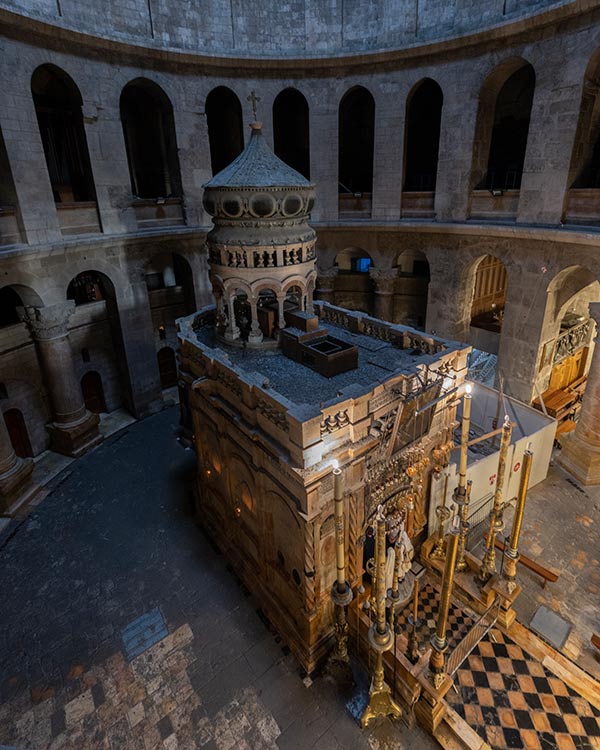
Jerusalem, Holy Sepulchre. Photograph by Kieran Dodds.
In the East, especially, over your head was a dome representing the dome of heaven, at the center of which was Christ Pantocrator, Christ in glory. This beatific vision was considered to be the goal of all human life, a union with God in Christ. Theologians disagree over whether the city images are to be physically realized or serve as metaphors. Either way, the vision of the city and our total redemption has been at the center of Christian hope since the beginning.
In churches across the old Roman Empire, from Africa and Palestine to the furthest reaches of Britain, liturgy was created to tell the story and to bring the spaces alive in the telling. Pilgrimages to Jerusalem and later to Rome and then to the tomb of Saint James in Spain became a kind of geographic liturgy. When the trip became too long or the Islamic threat too dangerous, believers found alternative destinations. Across the continent, from Magdeburg in Germany and Constance in Switzerland, to Bologna and Pisa in Italy and London and Cambridge in England, round churches or smaller models replicating the Church of the Holy Sepulchre became pilgrim destinations. After Constantinople fell to the Muslims in 1453 and the pilgrimage to Jerusalem became more hazardous, people in Italy began replicating that pilgrimage by building chapels with sculptures depicting Christ’s journey to the cross, his burial, and resurrection on hillsides, called sacri monti, close to home.
Before Constantine built the Church of the Holy Sepulchre, his mother, Helena, made the pilgrimage to find the holy sites … Golgotha, the Holy Sepulchre, the Cross. Her son used all the engineering and artistry at a Roman emperor’s command to build an icon of the heavenly Jerusalem on the site of the earthly one. Gold. Marble. Mosaic. No expense spared. Today you see only ruins of that first church and several that followed. The little gold that is there now was added much later. But, as C. S. Lewis has written, it is Christ’s resurrection that sets Christianity apart from all other religions. So it was the Holy Sepulchre itself and the image of Christ the Lamb of God in Glory that inspired church architecture and decoration for more than a millennium.
An early example can be found in Bologna. In the fifth century, according to tradition, Saint Petronius, bishop of the city, built a Church of the Holy Sepulchre complete with a reproduction of the sepulchre itself at the center. Today that replica is part of a group of chapels all under the name of Santo Stefano, Saint Stephen, the first martyr. This example is all in stone; its similarity to the edicule over Christ’s tomb is eerily accurate. In their solemnity and precision, these stones speak to the eternal reality they represent.
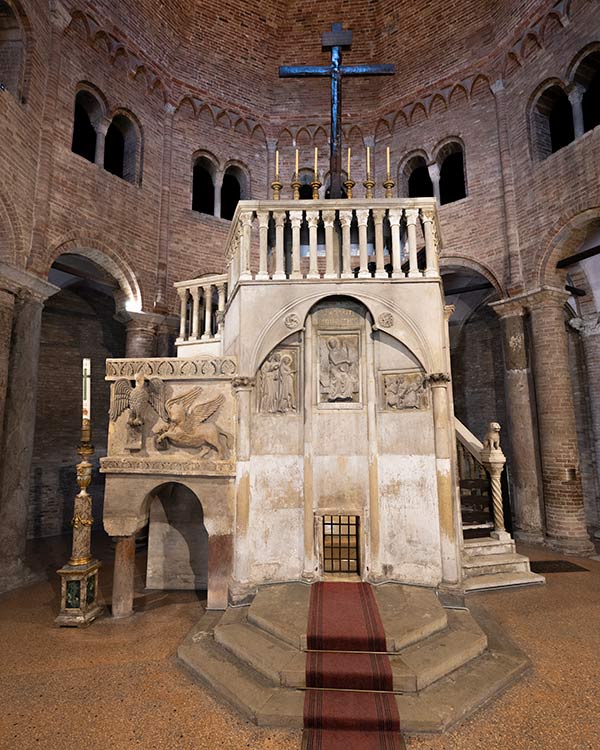
Bologna, Santo Stefano edicule. Photograph by Kieran Dodds.
In the early sixth century, a riot had given Emperor Justinian the opportunity to build his own great church in the capital city of Constantinople. The Nika Revolt of January 532 left Theodosius II’s Hagia Sophia (Holy Wisdom) in ruins. Justinian commissioned geometer and engineer Isidore of Miletus and mathematician Anthemius of Tralles to design the third church on the site next to the royal palace. The largest in the world for nearly a thousand years, the church’s giant dome seems to float on a band of windows. At certain times of the day light hovers 180 feet over the heads of those standing on the ground. Imagine that light ricocheting off golden mosaics, walls of red and green marble, and altar fittings of forty thousand pounds of silver. Contemporary historian Procopius praises the church’s just proportions and its “indescribable beauty.… The church is singularly full of light and sunshine; you would declare that the place is not lighted by the sun from without, but that the rays are produced within itself, such an abundance of light is poured into this church.”
The church was one of the main centers of life in the city. It functioned as a “spatial icon,” that is, a space where the art, architecture, decoration, music, incense, texture of the vestments, and the liturgy of the service all work together. No person there is merely seeing beautiful things, he or she is inside them, experiencing them directly. The presence of relics from Jerusalem, among which was believed to be the True Cross, meant that the holiness of Jerusalem had been transferred to that place. Those relics put Byzantine worshipers in direct physical contact with the holy … a holiness that made the place sacred as well. Perhaps even more importantly, the light itself functioned as an icon of the holy cloud that filled the Tabernacle and later the Temple whenever God was present, the cloud that had appeared on Sinai and that led the Israelites through the wilderness. The message was clear: Here is the city where God dwells.
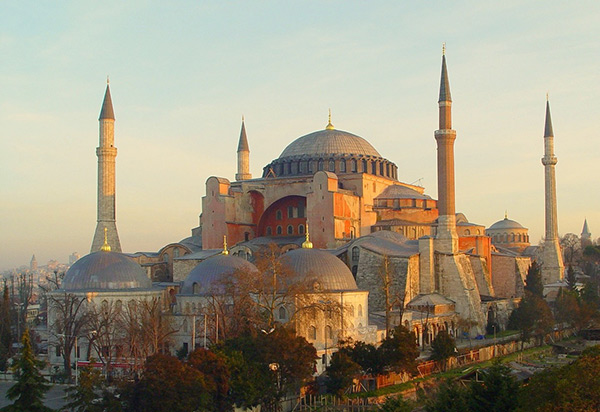
Istanbul, Hagia Sophia. Courtesy of the author.
Some 250 years later, further north, the Holy Roman Emperor Charlemagne built a palace-chapel in the form of a three-dimensional icon of the New Jerusalem at his capital at Aachen or Aix-la-Chapelle. The architect was Odo of Metz, and most scholars agree that Ravenna’s sixth-century San Vitale was the model. The Aachen church is designed to welcome Christ when he returns in glory to judge the living and the dead. This building, like San Vitale, is an octagon (which in early Christianity often symbolized the resurrection or rebirth). The ceiling was originally a mosaic, glittering and golden, showing the twenty-four Elders of Revelation bringing their crowns to Christ. It was copied for the later nineteenth-century restoration. The chandelier, given by Frederic Barbarossa, or Redbeard, and his wife Beatrice in the twelfth century, represents the wall of Jerusalem, here with eight golden gates instead of twelve in order to harmonize with the building.
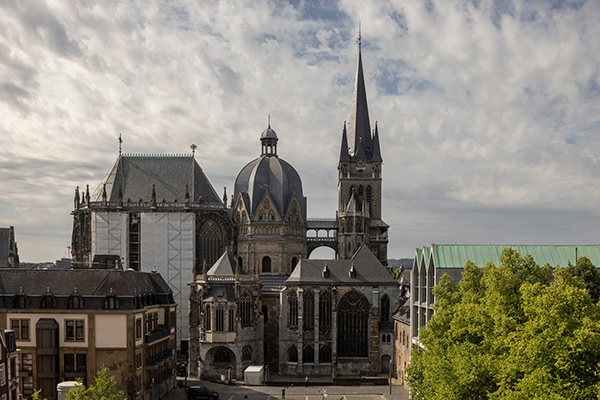
Aachen, Cathedral exterior. Photograph by Kieran Dodds.
Another example of a church building representing the City of God is the Church of San Miniato, begun on the hill above Florence, on the southern bank of the Arno River, in 1018. Minias had been a Christian Armenian prince serving in the Roman army under Decius in the mid-third century. As the story goes, he was stationed in a camp outside Florence when he decided to become a hermit. The emperor denounced him and ordered him thrown into the amphitheater with a panther. Legend has it that the panther refused to devour him and he was beheaded. He is supposed to have picked up his head and carried it to the top of Mons Florentius, where the Church of San Miniato is located today. I love these saints … Saint Denis in Paris is another … for their sheer audacity and intrepidity. Heads off? So what? They carried on anyway. We know that there was later a shrine and, by the eighth century, a chapel. In the eleventh century the church that still stands today was begun. With Christ in glory in a glittering thirteenth-century mosaic in its apse, the church stands as a symbol of the New Jerusalem.
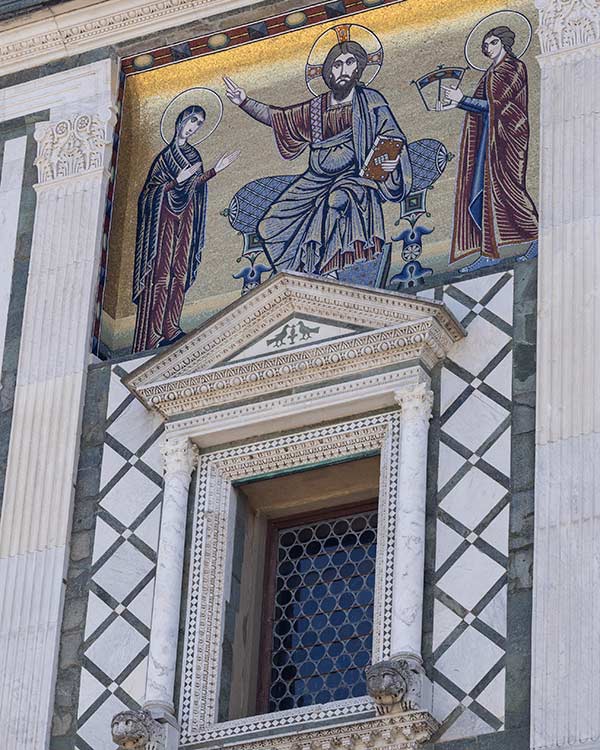
Florence, San Miniato. Photograph by Kieran Dodds.
At about the same time, just fifty or so miles away in Pisa, the Holy Land was on people’s minds. Many knights and an archbishop from the city had gone on the First Crusade, which reclaimed Jerusalem from its Muslim conquerors in 1099. Then, in 1113, the Pisan architect Diotisalvi designed an octagonal Church of the Holy Sepulchre, San Sepolcro, to house relics brought back from that crusade by Archbishop Dagobert. Just forty years later, the same Diotisalvi made the first design for the baptistery, again with the Holy Sepulchre in mind. At his death Nicola Pisano modified the original into the Romanesque building we see today, and a Gothic top was added even later. Pisan Archbishop Ubaldo Lanfranchi went on the Third Crusade in 1189, two years after Saladin took back Jerusalem. As the story goes, the archbishop brought back boatloads … the exact number of boats varies … of dirt from Golgotha. This dirt became the Camposanto, a sacred burial ground where a marble cloister was added in 1278.
As early as the late second century, Christians were making the journey to Jerusalem to visit the site of the Holy Sepulchre. But it was after Helena, mother of Constantine, made her famous pilgrimage to find the True Cross in the fourth century that pilgrimage to the Holy Land became a common practice. From then on, a regular industry developed around the needs of pilgrims. Still today you can see the ruins of hospices set up along the Anatolian coast for pilgrims to stay in. Muslim raids in the late seventh century crushed that route. Cities moved inland from the vulnerable coasts. But later on, pilgrims started making the journey again. In fact, in the eleventh century, complaints about Muslim harassment and even the killing of pilgrims were part of the reason for the Crusades. After Saladin recaptured Jerusalem in 1187, King Lalibela of Ethiopia took the dramatic step of building his own Jerusalem replica in the city that now bears his name, so Ethiopian pilgrims could make the journey in their own country. When I went there a few years ago with my husband, the city was filled with admiring tourists and the faithful alike. Ethiopian Orthodox Christians still regularly make the pilgrimage to Lalibela on Easter and Christmas.
Meanwhile, in Europe, the image of the New Jerusalem shaped not only buildings but the design of entire cities. Between the tenth and thirteenth centuries, the population from the Rhine to the Moselle increased ten times. More than twenty-five hundred towns or cities were founded in three centuries. These new towns were meant to facilitate living the Christian life put forward by Augustine in The City of God. Charity and communal practical life were a focus. Monasteries led the way in this new urban advance. Monks provided sanctuary to refugees and shelter to travelers, pioneered mechanical advances like water wheels, cleared land, copied and preserved priceless ancient manuscripts, and built bridges. New cities, like Magdeburg, followed their lead.
Life itself was expressed as a pilgrimage and every part of the town was conceived as a work of art. Mayernik shows how medieval Rome became the backdrop for its own pilgrim route. Though the pope is the head of the universal Roman Catholic Church, he is first of all the bishop of Rome. His election is held in the Vatican, but he must cross town to be installed as bishop at Saint John Lateran, the cathedral church of Rome. Over the centuries the route between the two churches became a pilgrimage, winding through the streets, stopping at churches, weaving through the ancient forum, claiming the city for God and for his church. The route, called the Possessio (Possession) and first documented in the twelfth century, formed a memory path to remind the people of important ideas and events. These cities were laid out with the understanding that they were earthly manifestations of the holy city to come, their goal to pattern the city of man according to the city of God, the New Jerusalem.
Let us look at an example of an ancient city, built not as a model of the New Jerusalem, but where the City of God provided the pattern for how the city could respond in times of catastrophe and calamity. By AD 568 Rome was in ruins, ravaged by 150 years of Goth, Vandal, Byzantine, and Longobard invasions. Once a city of perhaps 1.5 million, Rome bottomed out at thirty thousand. Outside the city, continual wars turned fields back into swamps. Invaders threatened and sometimes took over once-productive church-run farms. Malaria, cholera, and bubonic plague followed. Jobs evaporated. Once-flourishing estates were abandoned. Famine became a fact of life. Floods covered the city three or four times a century. Sewers and aqueducts needed repair.
The wealthy fled to the safety of Ravenna or even faraway Constantinople, Africa, or the Holy Land. But one son of an old Roman senatorial family, Gregory the Great, became pope in 590. Building on the existing infrastructure, Gregory set out to restore life to the city of Rome. He revamped rural papal estates to provide food for citizens, pilgrims, refugees, and urban poor, in fair and orderly ways. Gregory also made peace with the invaders, provided soup kitchens for the sick and infirm, and set up welfare offices or diaconiae in populated areas within the walls, administered by monastic congregations. The church rather than the state provided for the urban population.
A present-day example of the church as the embassy of the New Jerusalem comes from Ethiopia. From early on … no one knows exactly how early … the Ethiopian Orthodox Church has built its churches in small forests or stands of trees. Why? Well, we began in a garden; we are saved by the tree of the Cross; and we will live forever in a great garden city. Accordingly, across Tigrai and Amhara you can scan Google Maps and see circles of green dotting an otherwise rust-colored landscape.
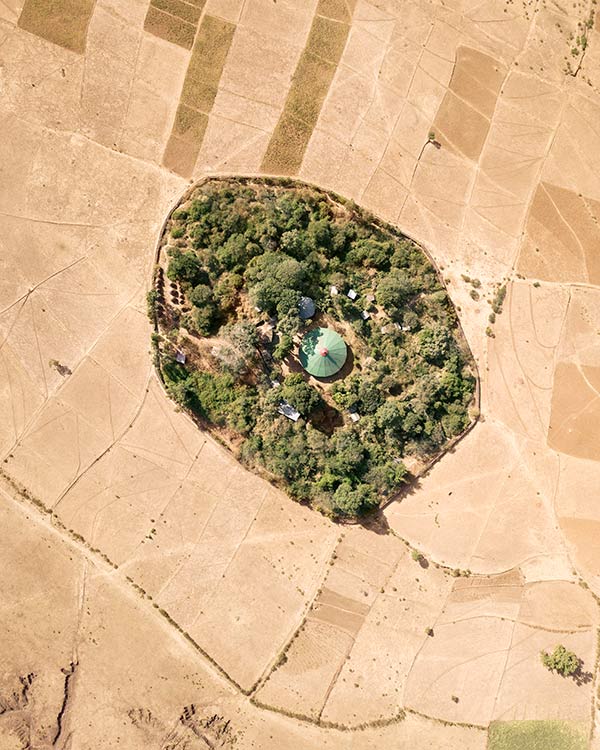
Ethiopia, Church Forests. Photograph by Kieran Dodds.
While one hundred years ago, 45 percent of Ethiopia’s land was forested, today, as a result of deforestation and urbanization, only 5 percent of that land is covered with trees. And most of that 5 percent surrounds the churches. Environmentalists have abetted a movement to save those church forests, the lifeblood of the water table and a greenhouse for a variety of plants and animals. The vision of the church as New Jerusalem is saving Ethiopia’s ecosystem.
Every year, I visit what is perhaps the only remaining great example of a Byzantine church: San Marco in Venice. Built in 1063, it is a replica of the great Church of the Holy Apostles in Constantinople, burial place of the emperors. Outside, the church is a Gothic wonder of flying domes, horses, stars in fresco skies, marble reliefs.
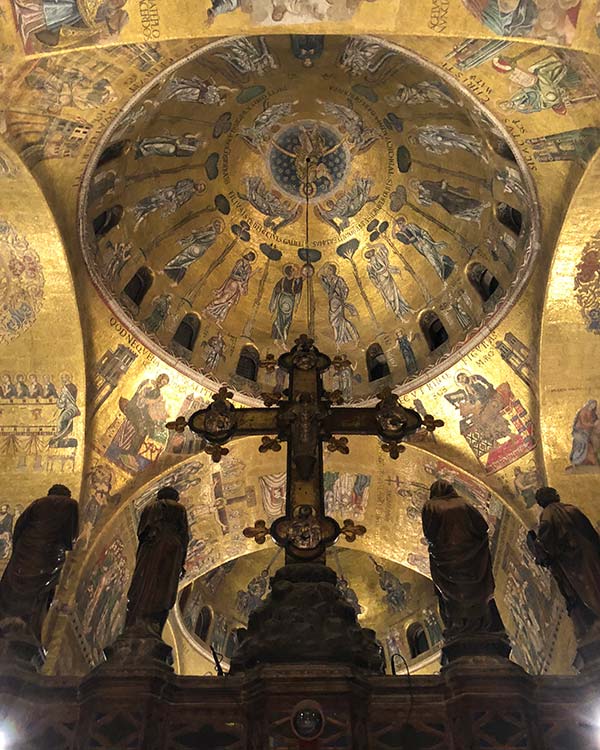
Venice, San Marco interior. Photograph by Colin Gilbert.
Inside, I sit and look up. Slowly the ceiling is filled with a soft glow. Above me hover three golden domes. Over the altar is Christ with the Evangelists, directly above is Christ ascending, and in the dome just behind, the Holy Spirit descends with flames of fire over the heads of the apostles and the Virgin Mary. I close my eyes, remembering a visit here some years ago. My friend Tom Oden, a man whose life had been transformed by reading the Church Fathers, and who was my companion on my first major journey to Hagia Sophia, had thrown his head back in awe. “I have seen the church of the apostles,” he said.
In beauty. In glory. In the promise of the New Jerusalem.
By studying the nature of that promised place, as artists and architects and writers of the past have sought to express it, we are schooled to live lives of wholeness and beauty right here on earth. The longing for beauty is ultimately a longing to be Home, to be in the place where we are whole. We start here, we start now.
Already a subscriber? Sign in
Try 3 months of unlimited access. Start your FREE TRIAL today. Cancel anytime.




































John Wilson Jr
I enjoyed the article a lot. In places it made me think of Margery Kemp who, as a woman, made more than one pilgrimage to the Holy Land. But her faith was such she was not easily accepted and at times not accepted at all. Her autobiography is, I think worth reading. Her faith enabled her to stand up to and confront people that could have her killed. She cried a lot, though, and that bothered people and her crying got her “thrown of the bus” or the medieval equivalent at a time when traveling alone, especially for a woman, was extremely dangerous. She was also a brewer whose ale was considered quite fine. But the article also made me think about the City of God. There are people from every nation on the face of the earth that are American citizens. In this respect America resembles a bit the Holy City. There was an interview in the news recently with a woman who recently emigrated from Northern Africa to France. She said she will always be seen as someone who emigrated to France. Her children will be first, second and so on emigres, but she and her children would never be seen as French. She also said that if she emigrated to America and received citizenship she would be seen and her children would be seen as American. I think this may be the only nation where this is the way of things. Unfortunately, too many Americans do not embrace this fact and only begrudgingly accept the citizenship of too many emigres. America offers a vision of a new city where we are all, no matter our nation of origin, not only citizens, as is, or can be the case in America, but where all are welcomed as citizens. We live in a time where Asians, people of Africa, and the Americas south of the border, no matter their citizenship are not accepted as citizens or potential citizens by many. America has the potential to be a truly remarkable place but the fallen nature of the people (and we are all fallen and are probably a bit tainted) keeps that potential from being realized.